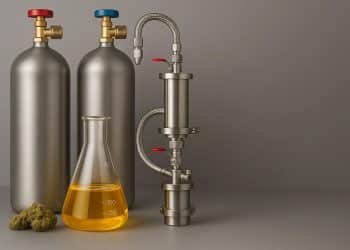A Greener, Safer, More Efficient Alternative?
The more mainstream cannabis extraction becomes, the greener, safer, and more efficient it needs to be. It’s this need that drove different researchers to investigate the potential of deep eutectic solvents (DESs) as an all-around better alternative to conventional organic solvents.
Nature of DESs
DESs are mixtures of at least one hydrogen bond acceptor (HBA) and one hydrogen bond donor (HBD), including carboxylic acids and other renewable compounds. According to Cai et al. (2019), “The strong hydrogen bonding interaction between HBA and HBD is the most important factor for the formation of DESs.” [1]
Benefits of DESs as Solvents
The benefits of DESs as solvents include “high thermal and electrochemical stabilities, nonflammability, negligible volatility, and high dissolving capacity,” as well as low toxicity, high biodegradability, low cost, and easy preparation and storage. [1]
These qualities cover pretty much the entire spectrum of what an extractor could want from a solvent.
Using DESs for Cannabis Extraction
Researchers from the Czech Republic tested how DESs perform by using them to extract four different cannabinoids — tetrahydrocannabinol (THC), cannabidiol (CBD), and their carboxylated precursors, tetrahydrocannabinolic acid (THCA) and cannabidiolic acid (CBDA). [2]
At first, they focused on menthol as the HBA and combined it with different carboxylic acids as the HBD in equal proportions. The menthol-formic acid combo reaped the best results for THC extraction in particular, whereas menthol-acetic acid was the most efficient in extracting all four cannabinoids.
DESs with other terpenes as the HBA (terpineol, linalool, geraniol, and borneol) and acetic acid as the HBD were also explored as extraction solvents, but they weren’t as efficient as the menthol based DESs.
The study found that not only was the menthol-acetic acid solvent the most efficient among the experimental DESs, but it was also more efficient than the mainstream extraction solvents methanol, ethanol, and chloroform across all four tested cannabinoids.
Even though the study notes that more research is needed to bolster its findings as each comparison was carried out only three times, the implications for the safety of both people and the environment are seriously promising. We’re looking forward to seeing what other DESs can be developed across a wider spectrum of renewable feedstocks and how they perform on similar tests.
References:
- Cai, et al. “Green Extraction of Cannabidiol from Industrial Hemp (Cannabis sativa L.) Using Deep Eutectic Solvents Coupled with Further Enrichment and Recovery by Macroporous Resin.” Journal of Molecular Liquids, 2019. Journal Impact Factor = 4.561
- Křížek, et al. “Menthol-based Hydrophobic Deep Eutectic Solvents: Towards Greener and Efficient Extraction of Phytocannabinoids.” Journal of Cleaner Production, 193, 2018, pp. 391-396. Journal Impact Factor = 6.395; Times Cited = 14
Image Credit: cepi












